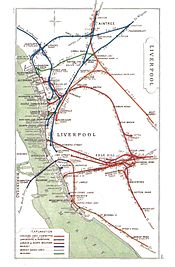
Merseyrail is a commuter rail network which serves Merseyside and adjacent areas of Cheshire and Lancashire. Merseyrail serves 69 stations, 67 of which it manages, across two lines – the Northern Line and the Wirral Line. The network uses 750 V DC third rail electrified lines having 75.0 miles (120.7 km) of routes, of which 6.5 miles (10.5 km) are underground. Since January 2023, Merseyrail commenced replacing its train fleet, withdrawing the Class 507 and 508 trains and introducing 53 new Class 777 trains. The network carried 25.5 million passengers in the 2022/2023 statistical period.

The Cheshire Lines Committee (CLC) was formed in the 1860s and became the second-largest joint railway in Great Britain. The committee, which was often styled the Cheshire Lines Railway, operated 143 miles (230 km) of track in the then counties of Lancashire and Cheshire. The railway did not become part of the Big Four during the implementation of the 1923 grouping, surviving independently with its own management until the railways were nationalised at the beginning of 1948. The railway served Liverpool, Manchester, Stockport, Warrington, Widnes, Northwich, Winsford, Knutsford, Chester and Southport with connections to many other railways.

Walton is an area of Liverpool, England, north of Anfield and east of Bootle and Orrell Park. Historically in Lancashire, it is largely residential, with a diverse population.
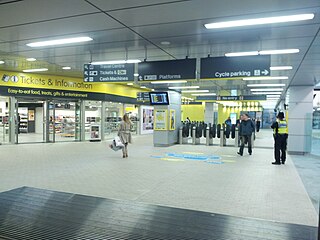
Liverpool Central railway station in Liverpool, England, forms a central hub of the Merseyrail network, being on both the Northern Line and the Wirral Line. The station is located underground on two levels, below the site of a former mainline terminus. It is the busiest station in Liverpool, though considerably smaller than Lime Street station, the mainline terminus, and the busiest station to operate solely on the Merseyrail network. The station is the busiest underground station outside London serving 40,000 people daily. The station in passengers per platform is the busiest underground railway station in the United Kingdom outside of London at 3,979,547 per platform per annum and coming tenth out of all stations outside the capital, underground or overground.

Liverpool Exchange railway station was a railway station located in the city centre of Liverpool, England. Of the four terminal stations in Liverpool's city centre, Exchange station was the only station not accessed via a tunnel.
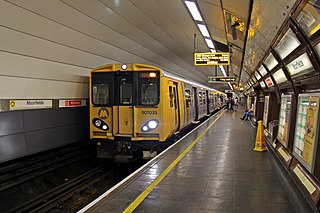
Moorfields railway station is an underground railway station in the city centre of Liverpool, England. The station is situated on both the Northern and Wirral Lines of the Merseyrail network. It is the third-busiest station on the Merseyrail network, and the largest underground station. It is also the only station on the network having services to all other Merseyrail stations.

Hunts Cross railway station is a Grade II listed railway station in Hunt's Cross, Liverpool, England. It is situated on the southern branch of the City Line (Merseytravel)'s Liverpool to Manchester Line route, and is the southern terminus of Merseyrail's Northern Line.
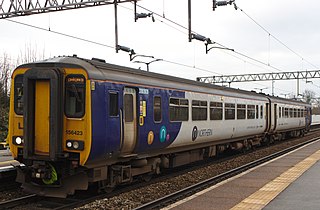
There once were four direct railway routes between Liverpool and Manchester in the North West of England; only two remain, the two centre routes of the four. The most northerly and the most southerly of the four routes are no longer direct lines. Of the remaining two direct routes, the northern route of the two is fully electric, while the now southern route is a diesel-only line. The most northerly of the four has been split into two routes: the western section operated by Merseyrail electric trains and the eastern section by diesel trains, requiring passengers to change trains between the two cities. The fourth route, the most southerly of the four, has been largely abandoned east of Warrington; the remaining section caters mainly for freight trains.

Old Roan railway station is a railway station in Aintree village, Merseyside, England, about seven miles north-east of Liverpool, on the Ormskirk Branch of the Northern Line of the Merseyrail network.

Garston railway station was a railway station in the Garston district of Liverpool, England. The station was located on the Northern Line of the Merseyrail suburban rail network. The station was closed in 2006 when it was replaced by Liverpool South Parkway, which is a combined bus and rail interchange. The proximity of the stations was so close the platforms of South Parkway nearly merged onto the Garston station's platforms.
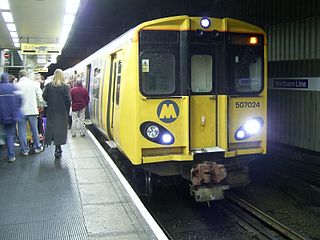
The Northern line is one of two commuter rail routes operated by Merseyrail and centred on Merseyside, England, the other being the Wirral line. The cross-city route runs from Hunts Cross in south Liverpool then branches in the north to terminate at Southport, Headbolt Lane and Ormskirk (Lancashire).

The Wirral line is one of two commuter rail routes operated by Merseyrail and centred on Merseyside, England, the other being the Northern line.

The North Mersey Branch (NMB) is a railway line that connected the Liverpool and Bury Railway at Fazakerley Junction with North Mersey and Alexandra Docks.

Kirkdale railway station is a railway station in Kirkdale, Liverpool, England, located to the north of the city centre on the Northern Line of the Merseyrail network. It acts as the interchange between the branches to Kirkby and Ormskirk; these lines diverge just north of the station.

Belle Vale is a district of south-east Liverpool, Merseyside, England and a Liverpool City Council Ward that covers both Belle Vale and Netherley.
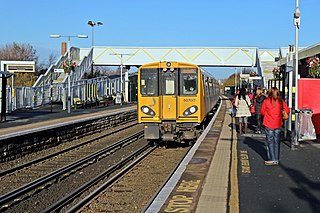
Aintree railway station is a railway station that serves the village of Aintree, Merseyside, England. It is on the Ormskirk branch of the Merseyrail network's Northern Line. Until 1968 it was known as Aintree Sefton Arms after a nearby public house. The station's design reflects that it is the closest station to Aintree Racecourse, where the annual Grand National horse race takes place.

Gateacre (for Woolton) railway station was located on the North Liverpool Extension Line on the north side of Belle Vale Road, Gateacre, Liverpool, England. Next door was the Black Bull public house which still stands.

The City Line is the brand name used by Merseytravel on suburban rail services in the Liverpool City Region starting eastwards from the mainline platforms of Liverpool Lime Street railway station.

Liverpool Central High Level was a terminus railway station in central Liverpool, England. It opened on 1 March 1874, at the western end of the Cheshire Lines Committee (CLC) line to Manchester Central. It replaced Brunswick as the CLC's Liverpool passenger terminus, becoming the headquarters of the committee.
Liverpool in North West England, is a major British city with significant road, rail, and ferry networks, in addition to an international airport and a well-known dock system. As with most other major UK cities, Liverpool's transport infrastructure is centred on its road and rail networks. Public transport services within the city are controlled and run by Merseytravel.



